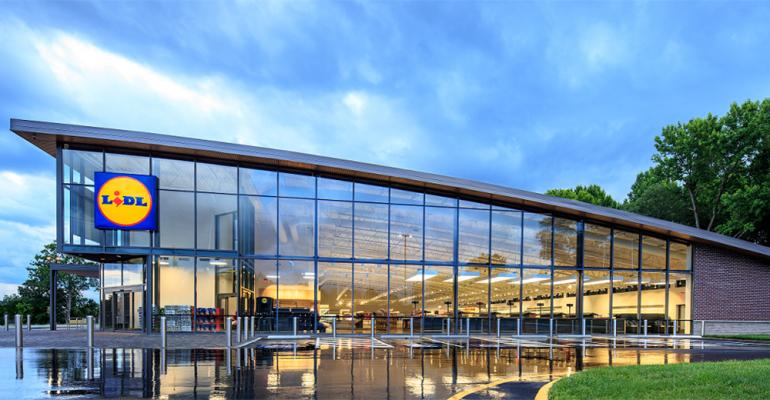While many retail headlines this year have been dominated by Amazon and Walmart battling it out on the e-commerce front, Lidl’s arrival to the U.S. grocery market this summer was also met with its share of headlines. But digging a little deeper, Lidl’s U.S. launch was not the beginning of the growth of the U.S. discount grocery and other value retailers market but instead another sign that the market is already quite strong and poised for further growth and competition. According to PlanetRetail, the discount channel will have a 5.8% annual growth rate globally. Discount grocery sales are also expected to increase from $74.8 billion in 2016 to $101.2 billion by 2021.
Just 10 years ago, 67% of U.S. shoppers reported that supermarkets were their primary grocery channel according to the Food Marketing Institute’s 2016 U.S. Grocery Shopping Trends Report. But in 2016, just 49% of U.S. shoppers reported that supermarkets are still their primary grocery channel. The average shopper is now using five to seven retail channels altogether and two to three shopping channels regularly. More than half of Americans feel overworked or overwhelmed, making convenience increasingly important to consumers. All of this points to a desire for a channel that simplifies their experience while not sacrificing quality.
The discount channel is getting a lot of things right about the U.S. consumer and that knowledge is fuelling the channel’s growth. Lidl and Aldi emergence is also helping to further speed discounters’ implementation of modern and easy-to-shop store layouts, more fresh and premium SKUs and the adoption of e-commerce. In return, consumers are flocking to their stores.
Here are six things discount grocers are getting right that’s benefitting their bottom lines.
· Good deals attract consumers from all economic levels. In most geographic markets, discount stores appeal to all customers and their biggest impact is attracting mid-market customers as well as some very affluent customers. In the U.K., one out of every three Aldi shoppers are middle or upper class. Customers are also motivated beyond price to shop with discounters. According to dunnhumby’s 2016 Customer Centricity Index study, customers who shop at Lidl repeatedly highlighted convenience and speed, product quality, excitement by being thrifty, discovery of new deals and finding special buys as reasons why they choose to shop there. The shopping experience at discount stores is no longer bare-boned, and as a result many customers are cutting back on their trips to traditional grocers since the discount stores now offer many of the items they need.
· Stores that are modern, convenient and offer a more supermarket-type experience with great value attract customers. Newer stores, such as Lidl, offer on-premise bakeries, abundant fresh produce and a wider footprint that are 40% larger than the Lidl stores in Europe. Keep an eye on Lidl’s stores, as they are only using about 55% of their 36,000-square-foot stores, which could signal they might add more SKUs as they learn what customers want.
· Discounters benefit by offering a wide selection of products including wine, produce, health and beauty, bakery and organic products. Gone are the days of discounters just focused on a narrow selection of products. Now they offer a curated, wider variety of products especially at key seasonal times. In September during New York Fashion Week, Lidl debuted a fashion line with Heidi Klum that is now available globally. Kroger has since announced that it will sell fashion in 300 stores, including Fred Meyer and Kroger Marketplace locations. In addition, many of the top discounters make sure their general merchandise special buys, like Lidl Surprises, are running every week since this helps drive new excitement and breadth of offer in customers’ minds.
· Discounters are customer-obsessed about their brand and model and keeping it very simple. They try to avoid complication at all costs so customers get the best value. And because most of their items are seasonal or weekly in nature, they can de-list lower performing items very quickly.
· Discounters are proving private labels can provide extremely good quality and amazing values. Lidl and Aldi obsess over the quality of their private branded products, and have been doing this for many years before they opened in the U.S. They have also expanded ranges of organic, free from and certified products. Brand leaders and other grocery retailers are mistaken to think their own "entry-price" and "value-tier" private label is comparable.
· Discounters are adopting multi-channels. Lidl and Aldi have started selling general merchandise goods online in some markets with some experts predicting they will add more click and collect services. In August 2017, Aldi announced it is partnering with Instacart to provide grocery delivery services to its customers. The grocery delivery service is currently being tested in Dallas, Atlanta and in certain areas of Los Angeles. The German discount chain currently has 1,600 U.S. stores and plans to have 2,500 by 2022 which will make it the third largest grocer in the U.S., behind only Walmart and Kroger. Lidl, meanwhile, is testing ecommerce in Belgium and in its home country of Germany.
David Clements is the global managing director of Retail for dunnhumby. With nearly 25 years’ retail industry experience, Clements is responsible for building dunnhumby’s global retail capabilities and ensuring the business builds strong partnerships to deliver great value to its partner clients.





